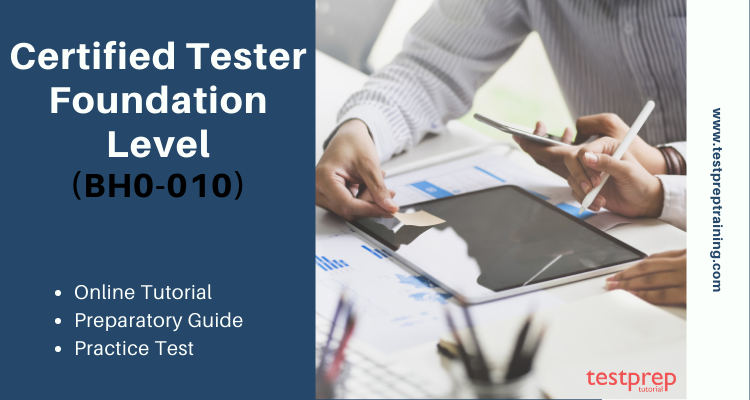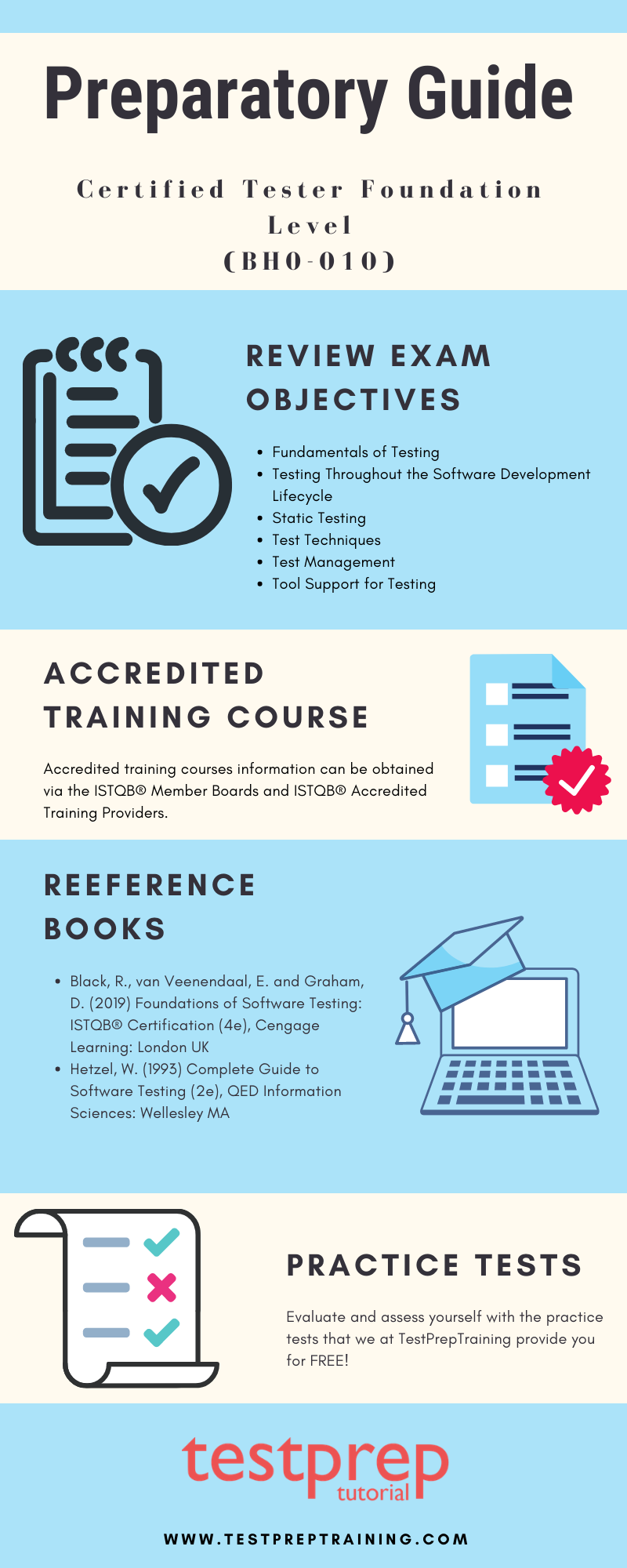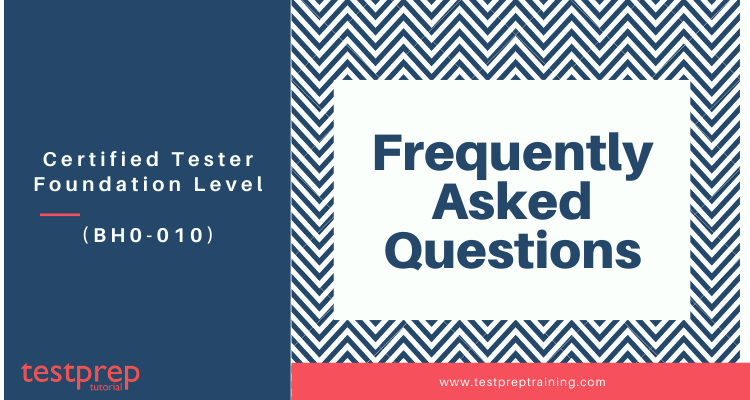(BH0-010) ISTQB Certified Tester Foundation Level

What is ISTQB Certified Foundation Level certification?
The ISTQB Certified Tester Foundation Level (BH0-010) exam aims at anyone involved in software testing. There are no formal entry requirements however, the candidate should have basic working IT knowledge. Holders of the Foundation Certificate will be considered as Certified Tester Foundation Level and should able to go on to higher-level software testing certifications.
Target Audience
The target audience for the exam includes people in roles such as testers, test analysts, test engineers, test consultants, test managers, user acceptance testers, and software developers. This Foundation Level qualification is also appropriate for anyone who wants a basic understanding of software testing, such as product owners, project managers, quality managers, software development managers, business analysts, IT directors, and management consultants.
BH0-010 Exam Details
| Exam Name | ISTQB Certified Tester Foundation Level |
| Exam Code | BH0-010 |
| Exam Duration | 60 minutes |
| Total Number of Questions | 40 |
| Passing Score | 65% |
| Exam Format | Multiple Choice Questions |
| Certification Validity | Lifelong |
| Exam Fees | £192 (£160 + VAT) |
Frequently Asked Questions
CLICK HERE to find answers to the frequently asked questions about the BH0-010 exam.
Course Outline
The New V4.0 ISTQB Certified Tester Foundation Level syllabus covers the following topics –
1. Fundamentals of Testing
1.1 What is Testing?
- FL-1.1.1 (K1) Identify typical objectives of testing
- FL-1.1.2 (K2) Differentiate testing from debugging
1.2 Why is Testing Necessary?
- FL-1.2.1 (K2) Exemplify why testing is necessary
- FL-1.2.2 (K1) Recall the relation between testing and quality assurance
- FL-1.2.3 (K2) Distinguish between root cause, error, defect, and failure
1.3 Testing Principles
- FL-1.3.1 (K2) Explain the seven testing principles
1.4 Test Activities, Testware and Test Roles
- FL-1.4.1 (K2) Summarize the different test activities and tasks
- FL-1.4.2 (K2) Explain the impact of context on the test process
- FL-1.4.3 (K2) Differentiate the testware that supports the test activities
- FL-1.4.4 (K2) Explain the value of maintaining traceability
- FL-1.4.5 (K2) Compare the different roles in testing
1.5 Essential Skills and Good Practices in Testing
- FL-1.5.1 (K2) Give examples of the generic skills required for testing
- FL-1.5.2 (K1) Recall the advantages of the whole team approach
- FL-1.5.3 (K2) Distinguish the benefits and drawbacks of independence of testing
2. Testing Throughout the Software Development Cycle
2.1 Testing in the Context of a Software Development Lifecycle
- FL-2.1.1 (K2) Explain the impact of the chosen software development lifecycle on testing
- FL-2.1.2 (K1) Recall good testing practices that apply to all software development lifecycles
- FL-2.1.3 (K1) Recall the examples of test-first approaches to development
- FL-2.1.4 (K2) Summarize how DevOps might have an impact on testing
- FL-2.1.5 (K2) Explain the shift-left approach
- FL-2.1.6 (K2) Explain how retrospectives can be used as a mechanism for process improvement
2.2 Test Levels and Test Types
- FL-2.2.1 (K2) Distinguish the different test levels
- FL-2.2.2 (K2) Distinguish the different test types
- FL-2.2.3 (K2) Distinguish confirmation testing from regression testing
2.3 Maintenance Testing
- FL-2.3.1 (K2) Summarize maintenance testing and its triggers
3. Static Testing
3.1 Static Testing Basics
- FL-3.1.1 (K1) Recognize types of products that can be examined by the different static test techniques
- FL-3.1.2 (K2) Explain the value of static testing
- FL-3.1.3 (K2) Compare and contrast static and dynamic testing
3.2 Feedback and Review Process
- FL-3.2.1 (K1) Identify the benefits of early and frequent stakeholder feedback
- FL-3.2.2 (K2) Summarize the activities of the review process
- FL-3.2.3 (K1) Recall which responsibilities are assigned to the principal roles when performing reviews
- FL-3.2.4 (K2) Compare and contrast the different review types
- FL-3.2.5 (K1) Recall the factors that contribute to a successful review
4. Test Analysis and Design
4.1 Test Techniques Overview
- FL-4.1.1 (K2) Distinguish black-box, white-box and experience-based test techniques
4.2 Black-box Test Techniques
- FL-4.2.1 (K3) Use equivalence partitioning to derive test cases
- FL-4.2.2 (K3) Use boundary value analysis to derive test cases
- FL-4.2.3 (K3) Use decision table testing to derive test cases
- FL-4.2.4 (K3) Use state transition testing to derive test cases
4.3 White-box Test Techniques
- FL-4.3.1 (K2) Explain statement coverage
- FL-4.3.2 (K2) Explain branch testing
- FL-4.3.3 (K2) Explain the value of white-box testing
4.4 Experience-based Test Techniques
- FL-4.4.1 (K2) Explain error guessing
- FL-4.4.2 (K2) Explain exploratory testing
- FL-4.4.3 (K2) Explain checklist-based testing
4.5. Collaboration-based Test Approaches
- FL-4.5.1 (K2) Explain how to write user stories in collaboration with developers and business
- representatives
- FL-4.5.2 (K2) Classify the different options for writing acceptance criteria
- FL-4.5.3 (K3) Use acceptance test-driven development (ATDD) to derive test cases
(BH0-010) Certified Tester Foundation Level Interview questions
5. Managing the Test Activities
5.1 Test Planning
- FL-5.1.1 (K2) Exemplify the purpose and content of a test plan
- FL-5.1.2 (K1) Recognize how a tester adds value to iteration and release planning
- FL-5.1.3 (K2) Compare and contrast entry criteria and exit criteria
- FL-5.1.4 (K3) Use estimation techniques to calculate the required test effort
- FL-5.1.5 (K3) Apply test case prioritization
- FL-5.1.6 (K1) Recall the concepts of the test pyramid
- FL-5.1.7 (K2) Summarize the testing quadrants and their relationships with test levels and test types
5.2 Risk Management
- FL-5.2.1 (K1) Identify risk level by using risk likelihood and risk impact
- FL-5.2.2 (K2) Distinguish between project risks and product risks
- FL-5.2.3 (K2) Explain how product risk analysis may influence thoroughness and scope of testing
- FL-5.2.4 (K2) Explain what measures can be taken in response to analyzed product risks
5.3 Test Monitoring, Test Control and Test Completion
- FL-5.3.1 (K1) Recall metrics used for testing
- FL-5.3.2 (K2) Summarize the purposes, content, and audiences for test reports
- FL-5.3.3 (K2) Exemplify how to communicate the status of testing
5.4 Configuration Management
- FL-5.4.1 (K2) Summarize how configuration management supports testing
5.5 Defect Management
- FL-5.5.1 (K3) Prepare a defect report
6. Tool Support for Testing
6.1 Tool Support for Testing
- FL-6.1.1 (K2) Explain how different types of test tools support testing
6.2 Effective use of tools
- FL-6.2.1 (K1) Recall the benefits and risks of test automation
ISTQB Certified Tester Foundation Level Exam Preparation Guide
For the (BH0-010) ISTQB Certified Tester Foundation Level exam, you will need proper guidance to succeed and pass the examination. However, to ease your preparation we have curated a preparation guide specially designed by our experts.

Review the Exam Objectives
Familiarize yourself with all the objectives and course domains of the exam. Devote enough time to each topic and have in-depth knowledge of the subjects. Moreover, this will also result in strengthening your preparation. Following outlines the objectives of the ISTQB Certified Tester Foundation Level exam:
- Firstly, Fundamentals of Testing
- Secondly, Testing Throughout the Software Development Lifecycle
- Thirdly, Static Testing
- Fourthly, Test Techniques
- Fifthly, Test Management
- Sixthly, Tool Support for Testing
Accredited Training Course
ISTQB Certified Tester Foundation Level training courses information can be obtained via –
Reference Books
Books are definitely the primary requirement while you study and prepare to crack the BH0-010 Exam. Finding the appropriate ISTQB Certified Tester Foundation Level book is of utmost importance. Following are 2 of the suggested readings that you might definitely want to check:
- Black, R., van Veenendaal, E. and Graham, D. (2019) Foundations of Software Testing: ISTQB® Certification (4e), Cengage Learning: London UK
- Hetzel, W. (1993) Complete Guide to Software Testing (2e), QED Information Sciences: Wellesley MA
Evaluate yourself with Practice Tests
Practice tests enhance your preparation for any exam. It helps candidates analyze their preparation and makes them aware of their weaknesses and strengths. Using ISTQB Certified Tester Foundation Level exam questions for practice can provide a better revision. Moreover, using ISTQB Certified Tester Foundation Level practice exam tests gives a boost to your confidence by making you familiar with the exam prior to it. We offer absolutely the latest and updated ISTQB Certified Tester Foundation Level mock exam tests for you to practice and master the exam.


